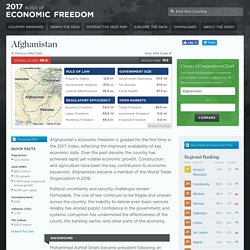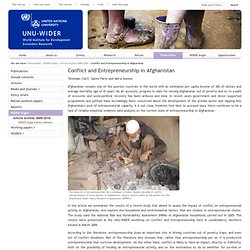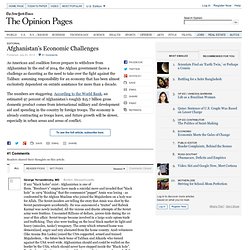

Profile of Mastoora Arezo, Afghan female entrepreneur. Afghanistan: Country Studies - Federal Research Division. Afghanistan Economy: Population, GDP, Inflation, Business, Trade, FDI, Corruption. Download PDF Quick Facts Population: 32.0 million GDP (PPP): $62.3 billion 1.5% growth 5.4% 5-year compound annual growth $1,947 per capita Unemployment: 9.6% Inflation (CPI): -1.5% FDI Inflow: $58.0 million Embed This Data Afghanistan’s economic freedom is graded for the first time in the 2017 Index, reflecting the improved availability of key economic data.

Over the past decade, the country has achieved rapid yet volatile economic growth. Construction and agriculture have been the key contributors to economic expansion. Political uncertainty and security challenges remain formidable. <iframe src=' scrolling='no' height='358' width='250' frameborder='0'></iframe><p style="font-size:11px; font-family:Arial, Helvetica, sans-serif; color: #808080; margin-top: 5px; background: transparent; text-align: center; width: 250px;">Read more about <a style="text-decoration:none !
Close Background Rule of LawView Methodology Government SizeView Methodology Open MarketsView Methodology. Entrepreneurship in Afghanistan. WIDER : Conflict and Entrepreneurship in Afghanistan. Tommaso Ciarli, Saeed Parto and Maria Savona Afghanistan remains one of the poorest countries in the world with an estimated per capita income of 300 US dollars and average mortality age of 47 years.

By all accounts, progress to date for moving Afghanistan out of poverty and on to a path of economic and socio-political recovery has been arduous and slow. In recent years government and donor supported programmes and policies have increasingly been concerned about the development of the private sector and tapping into Afghanistan's pool of entrepreneurial capacity. It is not clear, however, how best to proceed since there continues to be a lack of reliable empirical evidence (and analysis) on the current state of entrepreneurship in Afghanistan. The tenacity of entrepreneurship: An ironmonger in Kabul. According to the literature, entrepreneurship plays an important role in driving countries out of poverty traps, and even out of conflict situations. Concluding remarks About the authors. Afghanistan after 2014: Why zero is not an option. Afghanistan’s Economic Challenges.
The numbers are staggering.

According to the World Bank, an estimated 97 percent of Afghanistan’s roughly $15.7 billion gross domestic product comes from international military and development aid and spending in the country by foreign troops. The economy is already contracting as troops leave, and future growth will be slower, especially in urban areas and areas of conflict. To increase the odds for a more gradual and manageable transition, the United States and other major donors pledged $16 billion in development aid through 2015 at a conference in Tokyo last week. It was an important and necessary commitment.
Now they have to deliver. The United States and other nations have promised that they will not abandon Afghanistan, which happened in 1989 after the Soviet Union was pushed out. Not all the money has been wasted. The government has been unable to generate enough revenue to cover more than a fraction of its budget. Eventually, Afghanistan has to wean itself from its donors. The World Factbook. Women in Afghanistan ~ Employment. The 1940s and 1950s saw increasing numbers of Afghan women employed as nurses, doctors and teachers.

Afghan-Soviet relations had grown favorable during the early 1950s through increased trade agreeements between the two countries. Large sums of Soviet foreign aid and technical assistance initiated a modernizing effort within Afghanistan. By the late 1950s, women were increasingly encouraged to become economically active in order to help Afghanistan achieve its targeted development goals.
Then Prime Minister Mohammad Daoud approached the issue of women’s emancipation cautiously, declaring veiling voluntary and curtailing marriage expenses. These advancements for Afghan women were sustained throughout the 1970s and enforced by the People’s Democratic Party of Afghanistan after it obtained power in 1978. In fact, through the early 1990s, women were teachers, government workers and medical doctors.
However, women in Afghanistan’s professional world is still a revolution in the making.